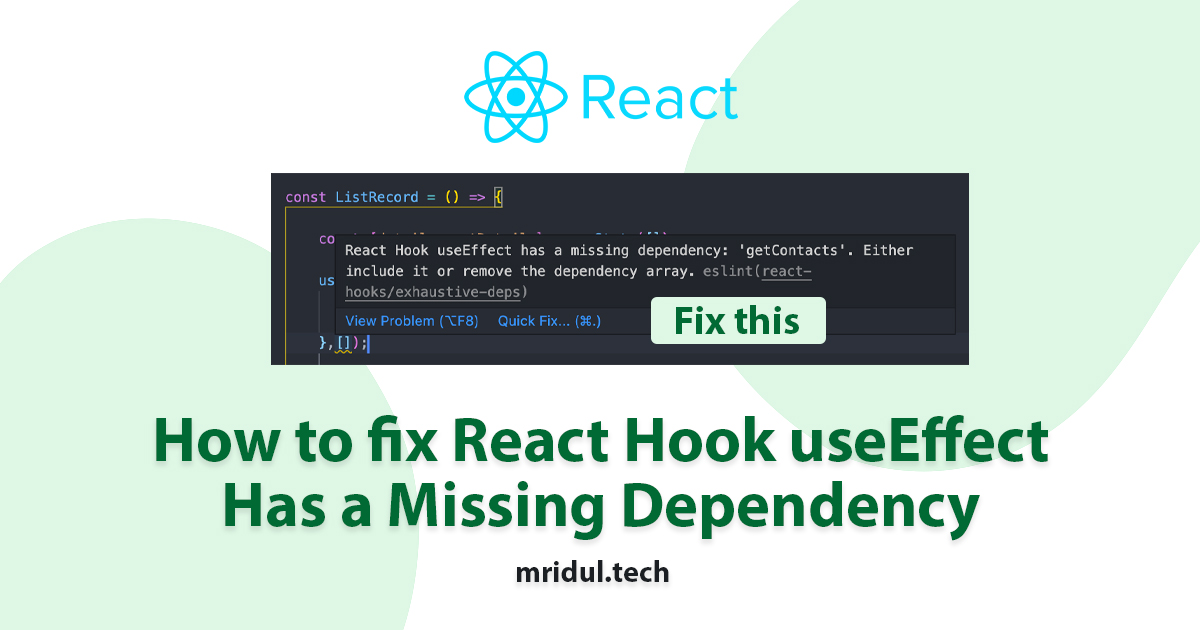Fix Missing Dependency Warning in React useEffect
Learn how to resolve the "React Hook useEffect has a missing dependency" warning and ensure your functional components behave as expected with this comprehensive guide.
Learn how to resolve the "React Hook useEffect has a missing dependency" warning and ensure your functional components behave as expected with this comprehensive guide.
This article delves into the common "missing dependency" warning encountered when using the useEffect Hook in React. We'll explore the reasons behind this warning and provide various strategies to effectively address it, ensuring your React components function as intended.
The "missing dependency" warning in React's useEffect hook can be confusing, but it's crucial for ensuring your components behave as expected. Let's break down the issue and explore ways to address it:
What Causes the Warning?
useEffect allows you to perform side effects in functional components, like fetching data, setting up subscriptions, or manually changing the DOM. It takes two arguments:
The warning arises when the effect function relies on variables or state values that are not included in the dependency array. This can lead to stale data and unexpected behavior.
How to Fix the Warning:
Here are several approaches to resolve the "missing dependency" warning:
1. Add Missing Dependencies to the Array:
useEffect(() => {
// Fetch data using the 'userId' state
fetch(`/api/users/${userId}`)
.then(response => response.json())
.then(data => {
// Update state with fetched data
setUserData(data);
});
}, [userId]); // Include 'userId' in the dependency array2. Use Functional Updates for State Values:
useEffect(() => {
setCount(prevCount => prevCount + 1);
}, []); // No dependencies needed as we use functional update3. Use useCallback for Functions:
useCallback.const fetchData = useCallback(() => {
// Fetch data logic here
}, []);
useEffect(() => {
fetchData();
}, [fetchData]); // Include the memoized 'fetchData' in the dependency array4. Ignore the Warning (with Caution):
eslint-disable-next-line react-hooks/exhaustive-deps comment to suppress the warning for a specific line.5. Refactor Logic:
Remember:
useEffect dependency array.useCallback to manage state and function dependencies effectively.By following these steps and understanding the underlying reasons for the "missing dependency" warning, you can write cleaner, more predictable, and efficient React components.
The provided JavaScript code snippets demonstrate various methods to address the "Missing Dependency" warning in React's useEffect hook. The examples cover scenarios such as adding missing dependencies to the dependency array, utilizing functional updates to state variables, employing the useCallback hook to memoize functions, and selectively ignoring the warning when appropriate. Additionally, the code showcases a refactoring technique to simplify complex logic within useEffect by introducing a calculated value using the useMemo hook.
Here are some JavaScript examples to illustrate the scenarios described in the article:
1. Adding Missing Dependencies:
function MyComponent() {
const [userId, setUserId] = useState(1);
const [userData, setUserData] = useState(null);
useEffect(() => {
fetch(`/api/users/${userId}`)
.then(response => response.json())
.then(data => setUserData(data));
}, [userId]); // userId is included as a dependency
// ...
}2. Using Functional Updates:
function Counter() {
const [count, setCount] = useState(0);
useEffect(() => {
const intervalId = setInterval(() => {
setCount(prevCount => prevCount + 1); // Functional update
}, 1000);
return () => clearInterval(intervalId);
}, []); // No dependencies needed
// ...
}3. Using useCallback:
function DataFetcher() {
const [data, setData] = useState(null);
const fetchData = useCallback(() => {
fetch('/api/data')
.then(response => response.json())
.then(setData);
}, []); // No dependencies for fetchData
useEffect(() => {
fetchData();
}, [fetchData]); // fetchData is a dependency
// ...
}4. Ignoring the Warning (with Caution):
useEffect(() => {
someFunctionThatUsesExternalVariable(); // eslint-disable-next-line react-hooks/exhaustive-deps
}, []); // Warning is ignored, but be cautious!5. Refactoring Logic (Example):
function MyComponent() {
// ...
useEffect(() => {
// Complex logic that depends on multiple state values and props
}, [stateValue1, stateValue2, prop1, prop2]); // Many dependencies
// ...
}
// Refactored version:
function MyComponent() {
// ...
const calculatedValue = useMemo(() => {
// Complex calculation based on state and props
}, [stateValue1, stateValue2, prop1, prop2]);
useEffect(() => {
// Simpler logic using the calculated value
}, [calculatedValue]);
// ...
}Remember: These examples demonstrate different approaches to handling the "missing dependency" warning. Choose the solution that best fits your specific use case and always prioritize code clarity and maintainability.
Common Scenarios and Solutions:
Advanced Techniques:
Debugging Tips:
react-hooks/exhaustive-deps rule to catch missing dependencies automatically.Trade-offs and Considerations:
useCallback or functional updates to address this.Remember: The "missing dependency" warning is a valuable tool for writing reliable and efficient React components. By understanding its causes and applying appropriate solutions, you can ensure your effects behave as expected and avoid potential bugs.
| Cause | Solution |
|---|---|
| Missing dependencies | Add missing variables/state to the dependency array. |
| State update issues | Use functional updates to ensure usage of latest state values. |
| Function dependencies | Wrap functions with useCallback for memoization. |
| Intentional ignore | Use eslint-disable-next-line comment (with caution!). |
| Logic issues | Refactor component logic for better structure. |
Mastering the useEffect Hook and its dependency array is essential for building robust and efficient React applications. By understanding the causes of "missing dependency" warnings and implementing the solutions discussed, you can ensure your components behave predictably and avoid unexpected bugs. Remember to carefully consider the trade-offs involved in dependency management and leverage advanced techniques and debugging tools to optimize your code. With practice and attention to detail, you'll be able to harness the power of useEffect to create exceptional user experiences in your React projects.
 How To Fix the “React Hook useEffect Has a Missing Dependency ... | Learn 3 different ways to fix the common error that developers encounter, the “React Hook useEffect has a missing dependency" error.
How To Fix the “React Hook useEffect Has a Missing Dependency ... | Learn 3 different ways to fix the common error that developers encounter, the “React Hook useEffect has a missing dependency" error. How to fix the missing dependency in useEffect React hook | by Bob ... | React is a popular library used for building web applications, and its useEffect hook is an essential feature for managing state and…
How to fix the missing dependency in useEffect React hook | by Bob ... | React is a popular library used for building web applications, and its useEffect hook is an essential feature for managing state and… How to fix – react hook useEffect has missing dependencies? | Facebook developed ReactJS as an open-source Javascript hook library for building fast and engaging web apps. Since then, React's popularity has been on the rise with more developers liking it. At first, components could be made only using classes. Then, hooks were introduced in React 16.8 as a breaking change which allowed developers to use
How to fix – react hook useEffect has missing dependencies? | Facebook developed ReactJS as an open-source Javascript hook library for building fast and engaging web apps. Since then, React's popularity has been on the rise with more developers liking it. At first, components could be made only using classes. Then, hooks were introduced in React 16.8 as a breaking change which allowed developers to use Fix useEffect missing dependencies warning with useCallback in ... | Here's how you can remove a "missing dependencies" warning in a useEffect hook
Fix useEffect missing dependencies warning with useCallback in ... | Here's how you can remove a "missing dependencies" warning in a useEffect hook Why does eslint warn about useEffect having a missing dependency ... | I tried to implement a simple data fetching example in ReScript-React, following the article How to fetch data with React Hooks, which I translated into ReScript as: let (items, setItems) = React.useState(() => []) React.useEffect0(() => { fetchData()->Js.Promise.then_(results => { switch results { | Belt.Result.Ok(data) => setItems(_ => data) Js.Promise.resolve() | Belt.Result.Error(msg) => Js.Console.log("Fetching data failed with error: " ++ msg) Js.Prom...
Why does eslint warn about useEffect having a missing dependency ... | I tried to implement a simple data fetching example in ReScript-React, following the article How to fetch data with React Hooks, which I translated into ReScript as: let (items, setItems) = React.useState(() => []) React.useEffect0(() => { fetchData()->Js.Promise.then_(results => { switch results { | Belt.Result.Ok(data) => setItems(_ => data) Js.Promise.resolve() | Belt.Result.Error(msg) => Js.Console.log("Fetching data failed with error: " ++ msg) Js.Prom... React Hook useEffect Has a Missing Dependency: How to Fix It | In this article, we will discuss the common error in React hook useEffect has a missing dependency. We'll explain how to fix it.
React Hook useEffect Has a Missing Dependency: How to Fix It | In this article, we will discuss the common error in React hook useEffect has a missing dependency. We'll explain how to fix it.